|
 |
Further Reading
The Complete Gods and Goddesses of Ancient Egypt, Wilkinson, Richard H. 2003
Dictionary of Egyptian Gods and Goddesses, A Hart, George 1986
Egyptian Religion, Morenz, Siegfried 1973 Cornell University Press
Gods and Myths of Ancient Egypt Armour, Robert A. 1986 American University in Cairo Press
The Gods of the Egyptians (Studies in Egyptian Mythology), Budge, E. A. Wallis 1969
|
 |
|
|
|
 |
Animals in Ancient Egypt
|
 |
|
Ancient Egyptian religion was not based on a set of theological principles, but rather the gods were connected to nature and the elements (earth, air, fire and water), or to animals. The ancient Egyptians believed in the infinite powers of the universe, and respected and worshiped each element that comprised it; they believed that the divine existed in everything.
Respect and veneration for animals was fundamental in all their traditions. They were given important status throughout the ancient Egyptians’ life and afterlife. Therefore, any appearance of the animal in their lives is in itself of religious importance, and often the worship of the animals was very direct, to the point where pets were found mummified and buried with their owners.
The ancient Egyptians were very sensitive to the characteristics of the animals: Anubis, who was a jackal (dog) weighed the heart of the dead for Osiris; any dog owner today will tell you that dogs can see the true heart and intent of a person. Bastet, who was a cat, was an important and infinite source of power throughout the ancient Egyptian religion: she was seen as the protector of home and hearth, and the goddess of fertility – the ancient Egyptians saw that cats were tender and protective of their young.
The gods (almost 80) were represented as humans, animals or a combination of human and animal form. The ancient Egyptians also believed that many of their gods and goddesses were reincarnated on earth as animals, and honored these animals in and around Ancient Egyptian temples, through daily rituals and annual festivals. They offered them food, drink and clothing. In temples, the high priests would watch over the statues being washed, perfumed and dressed in clothes and jewelry three times a day.
|
|
 |
Antelope
|
 |
|
 Gods: Sokar
Gods: Sokar
Attributes: royal, overseer
The head probably graced the prow of a ceremonial boat that stood in a temple sanctuary.
Boats decorated with antelope heads were sacred to the god Sokar, who was the overseer of the desert and the royal cemeteries near Memphis, Egypt's capital in the north.
|
|
|
 |
Baboon
|
 |
|
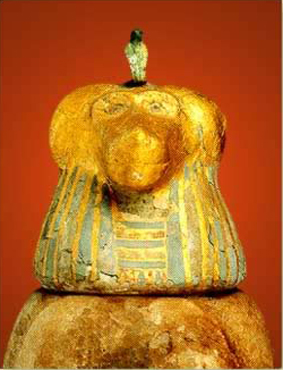 Gods: Thoth, the god of writing and recording; Khonsu - youthful moon-god; Hapy, the son of Horus was depicted with the head of a baboon.
Gods: Thoth, the god of writing and recording; Khonsu - youthful moon-god; Hapy, the son of Horus was depicted with the head of a baboon.
Attributes: Eloquence, strength, fairness, responsibility.
Among other things, Thoth was responsible for the lunar-based calendar, and was sometimes depicted with the head of a baboon on the scales of judgment Hapy was responsible for the canopic jar that held the lungs.
|
|
|
 |
Bull
|
 |
|
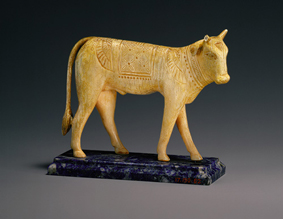 Gods: Ptah, Osiris
Gods: Ptah, Osiris
Attributes: Power, masculinity, fertility, regeneration
The bull was one of the most important animal gods in ancient Egypt. When an Apis bull died, it was embalmed and buried in great honor. From 1390 B.C. onwards, the Apis bull burial grounds were a huge and growing underground system of chambers called the Seapeum. The mothers of Apis bulls had their own cult and burial places.
|
|
|
 |
Cat
|
 |
|
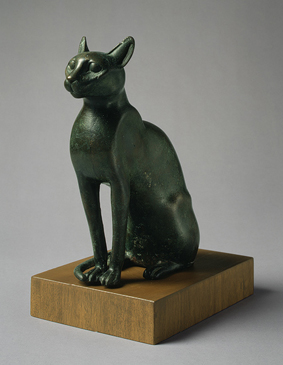 Gods: Bastet
Gods: Bastet
Attributes: Protector, defender, fertility, offspring, childbirth.
Cats were thought to have some of the most important divine powers. They were also seen as tender and protective of their offspring, and expectant mothers would wear amulets of Bastet with kittens.
|
|
|
 |
Cow
|
 |
|
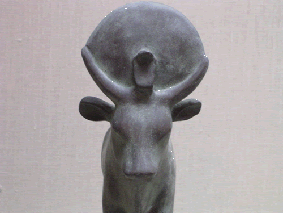 Gods: Hathor, Isis, Nut, Mehet-Weret, Bat
Gods: Hathor, Isis, Nut, Mehet-Weret, Bat
Attributes: Female fertility
These goddesses were often represented with cow horns or cow ears. The cow symbolized the pharaoh’s mother (as bulls represented the pharaoh).
|
|
|
 |
Cobra
|
 |
|
 Gods: Wadjet
Gods: Wadjet
Attributes: Justice, fertility, protection, royalty
Snakes in general were symbols of resurrection, and a giant snake called Methen guarded the sacred boat of Re as he sailed through the Underworld.
|
|
|
 |
Crocodile
|
 |
|
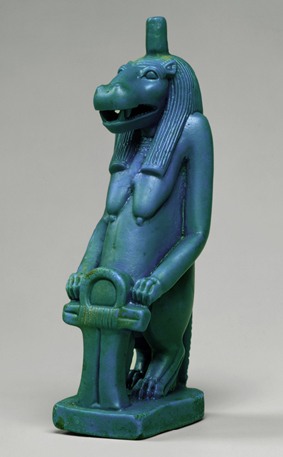 Gods: Ammut; Sobek; Taweret
Gods: Ammut; Sobek; Taweret
Attributes: Justice, power, respect
Ammut, the female demon in the judgement hall, had the head of a crocodile. She was known to devour the dead, and punished sinners by eating their hearts.
Sobek was portrayed as a human with the head of a crocodile, or as the crocodile itself. The temples of Sobek usually had sacred lakes where crocodiles were fed and cared for.
Taweret, the hippo goddess of childbirth, was thought to have the back and tail of a crocodile, or was shown with a crocodile perched on her back.
|
|
|
 |
Falcon
|
 |
|
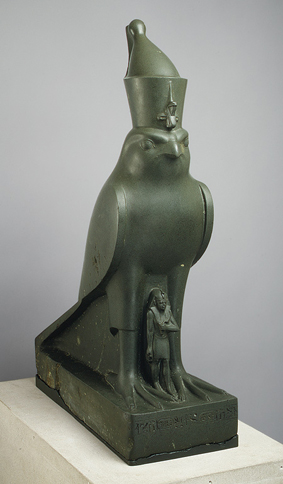 Gods: Horus; Montu; Socar
Gods: Horus; Montu; Socar
Attributes: Royalty, protection, strength
Horus was often depicted with the head of a falcon.
There was often a falcon with outstretched wings hovering over the head of the pharaoh.
Montu God of war also held the falcon as sacred.
Socar was the god of the Memphite cemetry.
|
|
|
 |
Frog
|
 |
|
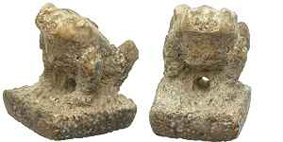 Gods: Heget; The four male primeval gods of the Ogdoad – Nun (water), Amen (invisibility), Heh (infinity), Kek (darkness)
Gods: Heget; The four male primeval gods of the Ogdoad – Nun (water), Amen (invisibility), Heh (infinity), Kek (darkness)
Attributes: fertility, resurrection, childbirth
Because the Egyptians saw that there were many frogs, all from the Nile, they associated the frog with fertility and resurrection
|
|
|
 |
Goose
|
 |
|
 Gods: Geb; Isis (his daughter); Amon
Gods: Geb; Isis (his daughter); Amon
Attributes: Strength
It was believed that Geb laid the egg from which the sun was hatched. His laugh was also known to create earthquakes.
He is known as the god of the earth.
|
|
|
 |
Hippopotamus
|
 |
|
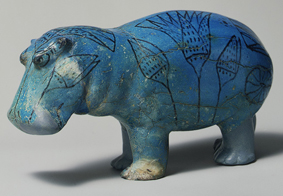 Gods: Set, Ammut, Taweret
Gods: Set, Ammut, Taweret
Attributes: Strength, protectiveness, justice, benevolence (female hippos), the household
Set was thought to have turned into a hippopotamus during his fight with Horus
|
|
|
 |
Ibis
|
 |
|
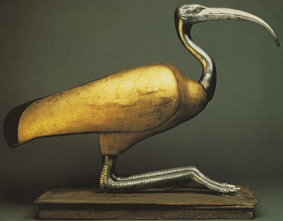 Gods: Thoth, Tehuty, Djehuty
Gods: Thoth, Tehuty, Djehuty
Attributes: Knowledge, part of the soul,
Though some stories place him as a son of Ra, others say that Thoth created himself through the power of language. He is the creator of magic, the inventor of writing, teacher of man, the messenger of the gods (and thus identified by the Greeks with Hermes) and the divine record-keeper and mediator.
|
|
|
 |
Jackal/Dog
|
 |
|
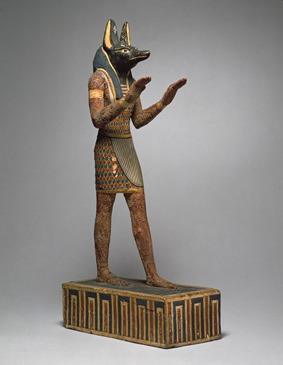 Gods: Anubis; Duamutef; Wepwawet; Sed
Gods: Anubis; Duamutef; Wepwawet; Sed
Attributes: Fairness, clairvoyance, sensitivity, judgment, guide
Anubis was the god of embalming and mummification. He guarded the canopic jar that held the stomach, and was given the title of “Opener of the Ways”, performing the Opening of the Mouth ceremony on the pharaoh so he would be able to speak in the afterlife.
Anubis also weighed the heart of the dead for Osiris.
The jackal was also thought to be a guide to the newly dead because they were often seen around the desert and mountains where the tombs were usually built.
|
|
|
 |
Lion
|
 |
|
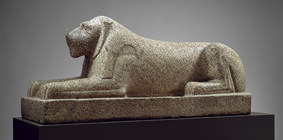 Gods: Aker; Shu; Tefnut; Hathor; Wadjet; Mut; Maahes; Sekhmet; Nefertem; Shesmu; Apedemak; Bes
Gods: Aker; Shu; Tefnut; Hathor; Wadjet; Mut; Maahes; Sekhmet; Nefertem; Shesmu; Apedemak; Bes
Attributes: Strength, leadership, royalty, ferocity, war, healing, beauty.
The rising and the setting of the sun; guardian of the horizon The earth god Aker was shown in the form of a 'double sphinx' - two lions seated back to back - and was thought to guard the sun as it entered and exited the underworld at the eastern and western horizons.
|
|
|
 |
Monkey
|
 |
|
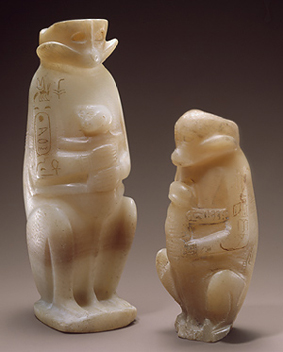 Gods: one of the more important animal forms into which many of the gods might be transformed
Gods: one of the more important animal forms into which many of the gods might be transformed
Attributes: rebirth, renewal
The maternal image was a symbol of rebirth and renewal, recurring concepts in the Egyptian belief system. Monkeys (and baboons) were also considered very important religiously,
|
|
|
 |
Ostrich
|
 |
|
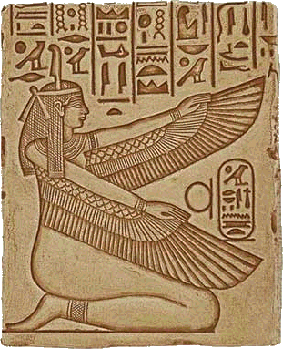 God: Ma'at
God: Ma'at
Attributes: the personification of order
Ma’at was shown as a seated woman wearing an ostrich feather as her headdress or as the feather itself.
|
|
|
 |
Pig
|
 |
|
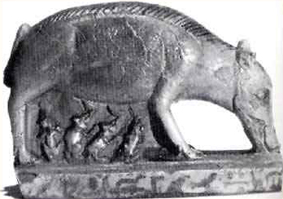 God: Set, god of chaos
God: Set, god of chaos
Attributes: chaos, sacrifice, sight
Set took the form of a pig and blinded Horus then disappeared. Eventually Horus regained his sight. The eyes of Horus was thought to represent the sun and the moon, and the legend of the blinding of the god was an explanation of solar and lunar eclipses.
|
|
|
 |
Ram
|
 |
|
 God: Banebdjedet; Khnum
God: Banebdjedet; Khnum
Attributes: Fertility, strength, birth
Khnum created men on his pottery wheel.
|
|
|
 |
Scarab Beetle
|
 |
|
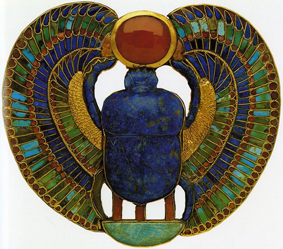 Gods: Khepri; Amen
Gods: Khepri; Amen
Attributes: Solar resurrection, new life, creation
As the scarab pushes its dung behind it in a ball, so the Egyptians thought that Khepri pushed the sun across the sky. Young scarabs emerged, born out of the dung, and so the scarab also came to symbolise new life and creation.
|
|
|
 |
Snake
|
 |
|
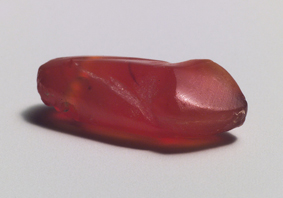 Gods: Apep; the four primeval goddesses of the Ogdoad - Naunet (water), Amaunet (invisibility), Hauhet (infinity) and Kauket (darkness); Nehebkau
Gods: Apep; the four primeval goddesses of the Ogdoad - Naunet (water), Amaunet (invisibility), Hauhet (infinity) and Kauket (darkness); Nehebkau
Attributes: danger and cure
The snake had mixed popularity in Egypt because snakes caused the danger and the cure to the venom.
Apep was a water snake-demon of the underworld, who tried to stop Ra on his nightly journey through the land of the west.
|
|
|
 |
Scorpion
|
 |
|
 Gods: Serqet, Tabitjet
Gods: Serqet, Tabitjet
Attributes: Poison and protection; prevention and cure; virginity
The scorpion was sacred to Isis, who was thought to have been protected by scorpions while Horus was young.
|
|
|
 |
Vulture
|
 |
|
 Gods: Nekhbet; Mut
Gods: Nekhbet; Mut
Attributes: eternity; monarchy, leadership
The vulture often holds the shen (shn) symbol of eternity in its talons, offering eternal protection to the pharaoh.
|
|
|
|